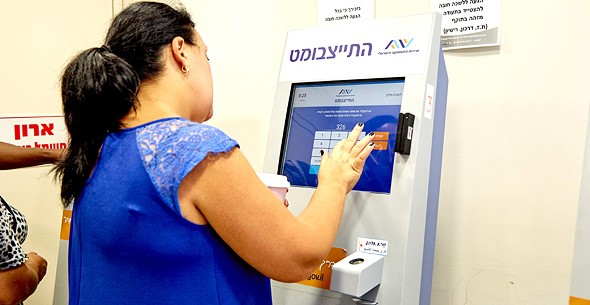The total number of unemployed workers in Israel has risen to around 800,000, according to figures issued by the Central Bureau of Statistics and the Employment Service on Monday, February 15. This is a significant increase of more than 40% compared to the figure of 565,000 unemployed in Israel issued on in January 4.

A newly unemployed woman enters details of her recent dismissal from work via a dedicated monitor in an Employment Service office. (Photo: Employment Service)
The large jump in the number of the unemployed since the start of the year is attributed to the third nationwide COVID-19 lock down imposed on Dec. 27, 2020, some of its restrictions still being in effect. With the newest figures, the overall unemployment rate in Israel currently stands at 19.5%, compared to 13.9% in early January, 22.7% in mid-October and a peak of 27.5% at the end of April 2020, when there were more than 1 million unemployed.
During Israel’s first and second closures, women bore the brunt of the economic impact: 11% more women than men were dismissed from work with the first closure and 7% more were laid off with the second lock down. Significantly, during months in which closures were not enforced, unemployment rates were similar for both genders.
Workers in restaurants, tourism, and the fields of art and culture had the highest unemployment rates during 2020, while those occupied as software developers and essential service providers like teachers and doctors had unemployment of less than 5% during periods when the economy was open.
According to a report published by the Labor and Welfare Ministry last week, some 47% of workers in Israel have jobs that allow them to work from home, higher than all OECD capitalist countries with the exception of Luxembourg, and significantly higher than the OECD average of 38%.
In Israel, more women than men worked from home during the pandemic: Some 32% of Jewish women and 19% of Arab women worked remotely during the past year, compared to 28% of Jewish men and 7% of Arab men. Israel’s high work-from-home rate was attributed to the large percentage of hi-tech workers and teachers in the working class compared to the OECD average.
However, the last Labor and Welfare Ministry report also found that workers in Israel work longer hours than the average for OECD country workers, and are obligated to be more flexible in their schedules. A worker in Israel can be employed up to 12 hours a day (including overtime) and up to 58 hours per week, while workers in Denmark and Ireland, for example, may not average more than 48 hours per week.


